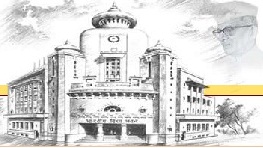
The Bhavan was founded in 1938, about a decade before the dawn of Indian independence by Kulapati Dr. K.M.Munshi, a far sighted visionary and practical idealist, with the blessings of Mahatma Gandhi and the co-operation of Sri Rajaji, Dr.Rajendra Prasad, Pandit Jawaharlal Nehru, Sri Sardar Patel, Dr.Radhakrishnan, and several other stalwarts. It is totally political and is solely devoted to the promotion of education and Indian culture.
Our Founder
Versatile”, “a philosopher in action”, “a man of great ideas and courage”, “a multi-faceted genius” -these are the ways in which friends and admirers describe Dr. Kanhaiyalal Maneklal Munshi, the founder of Bharatiya Vidya Bhavan. The versatility of Munshiji is seen in his roles as a lawyer, creative writer, constitution-maker, freedom fighter, administrator, organization-builder and champion of Indian culture. Dr. Munshi looked upon himself as a “sea shell thrown up by the mighty flood of Indian renaissance.”

He founded the Bharatiya Vidya Bhavan along with a few friends late in 1938. He said, “We, the Bhavan’s family, whether it is the smaller one or the larger one, must make every effort in restoring an awareness of these values -Satyam, Shivam, and Sundaram -Truth, Love, and Beauty- in personal and collective life.” In the words of Dr. Radhakrishnan, “The Bhavan is the greatest monument of Munshi’s life.
Born in Bharuch in Gujarat on 30th December 1887, Munshiji came under the influence of Sri Aurobindo while studying at Baroda College. A prize winner at the B.A. and LL.B. examinations, he enrolled himself initially as a Pleader and later as an Advocate in the Bombay Bar. He first joined Dr. Besant’s All India Home Rule League in 1916 and later the Indian National Congress.
He married Lilavati Sheth in 1926 (who was one of his literary critics) after the death of his first wife, Atilakshmi Pathak, whom he married when he was just 13.
He was elected to the Bombay Legislative Council in 1927. He took part in the Salt Satyagraha in 1930 and was imprisoned for 6 months. In 1932, he was sentenced to two years of rigorous imprisonment. He was elected to the Bombay Legislative Assembly in 1937 and appointed the Home Minister in the first Congress Government. He served as India’s Agent-General in Hyderabad when the Nizam was trying to keep his State independent of the Indian Union. He became a member of the Constituent Assembly in 1948. He was the Food and Agriculture Minister of the Government of India in 1950. He was Governor of Uttar Pradesh during 1952-57.
He resigned from Congress and became the Vice President of the newly formed “Swatantra Party” standing for free enterprise. Till his death in 1971 he devoted all his energies to the building up of the Bhavan as the premier cultural organization of the country.
Dr. Munshi is reckoned as one of the luminaries of Gujarati literature and established his reputation as an outstanding novelist, particularly in historical romance. His “Kulapati’s Letters,” contributed to the Bhavan’s Journal, are widely read and appreciated.
Bharatiya Shiksha must:
Ensure that no promising young Indian of Character having faith in Bharat and her culture should be left without modem educational equipment by reason merely want of funds.
Be formative more, than informative, and cannot have for its end mere acquisition of knowledge. Its legitimate sphere is not only to develop natural talents but so to shape them to enable them to absorb and express the permanent values of Bharatiya Vidya.
Take into account not only the full growth of a student’s personality but the totality of his relations and lead him to the highest self-fulfillment of which he is capable.
Involve at some stage or other intensive study of Sanskrit or Sanskritic languages and their literature, without excluding if so, desired, the study or other languages and literature ancient and modem.
Stimulate the student’s power of expression, both written and oral, at every stage in accordance with the highest ideals attained by the great literary masters in the intellectual and moral spheres.
The adoption by the teacher of the Guru attitude which consists in taking a personal interest in the student; inspiring and encouraging him to achieve distinction in his studies; entering into his life with a view to forming ideals and removing psychological obstacles; and creating in him a spirit of consecration; and
The adoption by the student of the Shishya attitude by the development of:
a) Respect for the teacher
b) Spirit of inquiry.
c) Spirit of service towards the teacher, the institution, Bharath and Bharatiya Vidya.
The ultimate aim of Bharatiya Shiksha is to teach the younger generation to appreciate and live up to the permanent values of Bharatiya Vidya which flow from the supreme art of creative life – energy as represented by Sri Ramachandra, Sri Krishna, Vyasa, Buddha and Mahavira, who have expressed by themselves in modern times in the life of Sri Ramakrishna Paramahamsa, Swami Dayananda Saraswathi, Swami Vivekananda, Sri Aurobindo and Mahatma Gandhi.
Bharatiya Shiksha while equipping the student with every kind of scientific and technical training must teach the student not to sacrifice an ancient form or attitude to an unreasoning passion for change; not to retain a form or attitude which in the light of modern times can be replaced by another form or attitude which is a truer and more effective expression of the spirit of Bharatiya Vidya; and to capture the spirit afresh for each generation to present it to the world.
